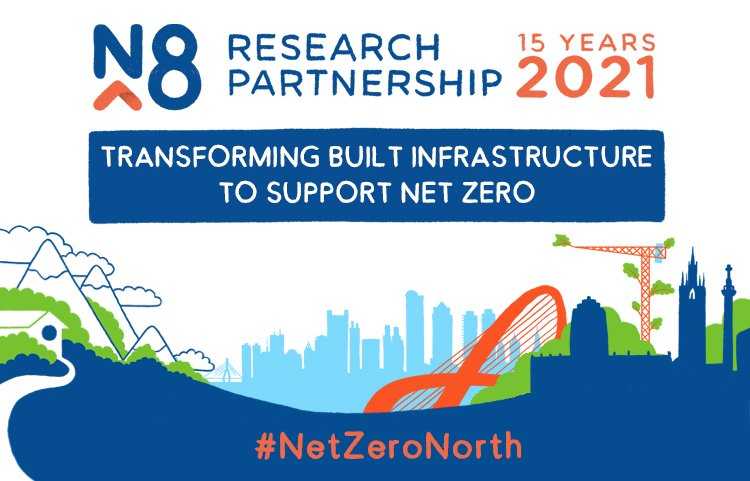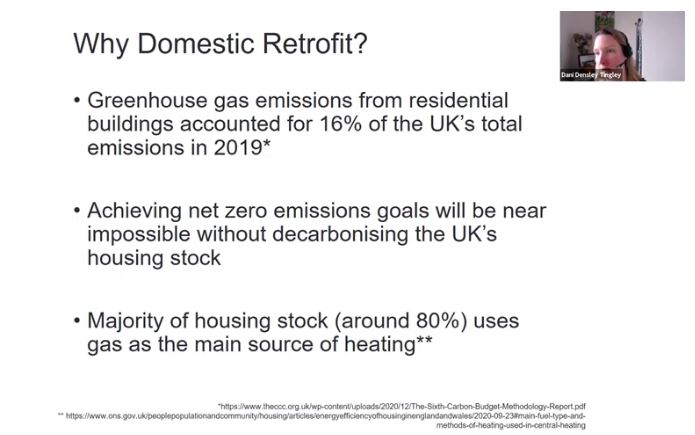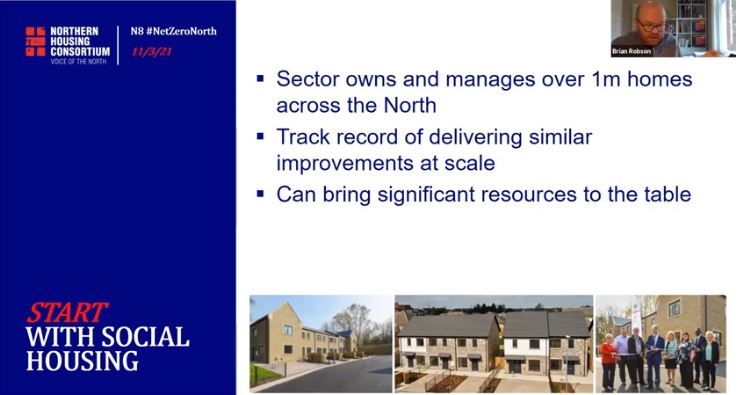
As part of the N8 Research Partnership’s ambitious Net Zero North agenda, we recently held the second in a series of Net Zero North webinars, exploring how people and businesses in the North of England can support meeting climate targets. While our first webinar explored how natural resources can support green growth, our second moved away from the countryside and into the bricks and mortar that surrounds us all.
The webinar interrogated how the North can lead the transition to low-carbon construction methods and building retrofit by supporting skills and training, innovation, and wider community adoption.
Retrofit of buildings is one of the key actions recommended in the Climate Change Committee’s 6th Carbon Budget, but also one of the costliest. It is estimated that the Balanced Pathway requires investment of £12bn annually, leading to £5bn p.a. of savings in operating costs. 200,000 jobs would need to be created in the 2020s through to 2050 to deliver these changes.
The webinar – chaired by distinguished Professor of Design Management and Policy at Lancaster University, Dr Rachel Cooper – focussed on the role that the built environment can play on delivering the carbon reductions needed to support the UK’s 2050 net zero target and in supporting a green recovery from the pandemic, and how attitudes can be changed and innovation enhanced in order to achieve this.
The event’s first speaker was Suzy Jones – Director of Future Lab at House by Urban Splash, the award-winning regeneration company that since 1993 has renovated countless buildings that were earmarked for demolition.
“We see the building as it exists already, and work out what formula is needed to give it a new lease of life,” explained Suzy. “At Urban Splash, we’ve been enormously successful doing that and the approach arguably shaped the landscape of our cities today. As a result, we’ve retained lots of amazing buildings and developed them for many different types of purposes. Urban Splash set about shaping the future it envisaged and in doing so helped shape the construction industry itself.”
Suzy used the example of the Fort Dunlop building in Birmingham as a prime example of retrofit. Located next to the M6 motorway, Urban Splash purchased the former tyre factory in 1998 and set about creating over 300,000 square feet of office space. At the time, said Suzy, there was rampant scepticism regarding Urban Splash’s methodology:
“We were told by our agents that it would never work, and that to sell those units we needed to get BREEM excellence ratings which could only be achieved by knocking the factory down and creating a new building. Fort Dunlop wasn’t eligible for such ratings as it was an existing building – but we stuck to our principles, and today it’s a successful multi-use development.”
Suzy went on to explore the synergies between revitalising a commercial building such as Fort Dunlop with Urban Splash’s work in residential development.
“Urban Splash already does things very differently to the majority of traditional house builders,” said Suzy. “We build our homes in a factory, we design to a very high specification and we deliver homes with huge windows and really high ceilings – but there’s lots more we want to do.”
Urban Splash, continued Suzy, is focused on exploring the ways in which technological advancements influence the way we may need and want to live in the future.
Future Lab is currently exploring many other speculative and highly ambitious ways to increase sustainability within the construction process. While its current carbon credentials are good, large scale shifts in thinking are required to produce the results that will support the UK reaching the 2050 net zero target.

Circular economies
Key to this will be introducing circular practices across every aspect of operations – for example, a building can be designed with green credentials but if timber is not reused at the end of a product lifecycle then that good work will be undone.
It’s also imperative that circular thinking is expanding into the vertical integration of the business as a whole, said Suzy: “Future Lab is beginning to ask questions like: can we own a forest? Can we own a permaculture forest which retains the carbon in our materials at the end of their life and provide new timber for future products? Can that forest contain a timber processing plant and can it also have a manufacturing facility that localises the timber supply chain, and how we can form a community for the people that work there?”
Ultimately, said Suzy, her current aim is to continue to push the boundaries of how new products can be designed from scratch to ensure materials are reused adequately at the end of their life.
For our next speaker – Dr Danielle Densley-Tingley – Senior Lecturer in Architectural Engineering, University of Sheffield, advances within circular economies was also a crucial point. Danielle is also director of the Urban Flows Observatory and principle investigator of the EPSRC funded project ‘Multi-scale, circular economic potential of the non-residential building stock’ and a co-Investigator of the Active Building Centre, working on the retrofit stream of work, and began her presentation by warning that achieving current net zero emission goals will be impossible if existing residential stock, the majority of which uses gas or fossil fuels as their main heating source, are decarbonised.
“There are nearly 23 million houses in England alone, and only 1% of the housing stock actually meets modern standards of thermal efficiency, which in themselves are insufficient if we’re going to deliver net zero,” said Danielle.
Heating is a key challenge, with the difficulties associated with changing energy supply from gas to electric a complex issue.
“It’s very difficult to electrify the systems. Partly that’s because there are 23 million homes that you’re going to have to retrofit,” said Danielle. “But it would also be very difficult to shift that current gas demand straight on to the electricity grids given current capacity in the power network, across generation, transmission and distribution.”
The need to decarbonise the heating process is not just an environmental issue, explained Danielle. Four million households in the UK are in fuel poverty, meaning they’re unable to heat their homes. Consequently, such families should be targeted for retrofit interventions first. This would have a knock on effect in reducing services required by the NHS as result of illness caused by living in cold homes.
Prohibitive costs
However, as Danielle pointed out, one of the key challenges for retrofit is the cost of doing it. Danielle then explored the different retrofitting measures that can be deployed: insulation, double and triple glazing, and installation of heat pumps, and in addition to a series of these combined measures.
“The challenge with shifting the whole system to a heat pump – forget for a second the logistical challenges – is also that heat pumps run at much lower temperatures than our typical heating systems,” said Danielle.
“This generally means to provide thermal comfort, you need to have a very well insulated stock. So ideally, we are going to then need to combine those heat pumps with full installation scenarios and possibly better glazing as well. However, this is incredibly challenging to do.
“We urgently need new legislation incentives and financial support to actually be able to increase the pace and scale of retrofit if we’re to meet decarbonisation targets. “
Not if, but when
For Brian Robson, Executive Director of Policy & Public Affairs, Northern Housing Consortium, there was no doubt that mass retrofitting of residential stock will soon be a reality.
“It’s very much not about if we do this, but how we do this,” he said. “Our members are really serious about net zero. Half our members are councils and over 60 of them have now declared climate emergencies. The amount of emissions that come our existing homes means housing will have a huge role in the north meeting the challenge of net zero.”
For the government, argued Brian, developing a more sustainable approach to construction also represented the opportunity to deliver on other goals.
“A large scale retrofit program in our existing homes offers the opportunity to address both net zero and the levelling up agendas. For us levelling up means creating good green jobs in addition to levelling up the quality of our homes in the North, which are older and colder than the national average.”
In support of this point, Brian went on to discuss a recent study the Northern Housing Consortium had undertaken with IPPR North which sought to develop a green recovery plan to decarbonise homes in the north. This plan has the potential to create 77,000 new green jobs in the North by 2035:
“This would involve retrofit measures in over five million homes and have a huge economic impact. We propose starting in the social housing sector, because we think that offers a real opportunity to build the skills and supply chains that we’re going to need to decarbonise all the homes we have in the north of England. As Danielle said earlier, the poorest standards are often in solid wall properties. They’re very often in the private rented and owner occupied sectors.”

Northern power
Due to the large scale of social housing in the north – the sector owns and manages over a million homes in the region, or one in six of all properties – there is the opportunity to lever that scale to instil certainty into the construction supply chain in a manner that wouldn’t be possible if work was being undertaken at direction of individual homeowners or private landlords. The Decent Homes program at the start of the century was used as an example by Brian of how the social housing sector had delivered such an undertaking in the past.
The scale of the housing sector across the north means it is therefore well placed to support the drive to net zero, but it is not without challenges.
“While we have 100,000 registered gas engineers in the UK we only have 600 heat pump installers. So we don’t have the skilled workers at present with the right skills, the right training, the right accreditation, to take on the scale of home improvement that we need to do in the north,” said Brian.
“We therefore need to retrofit our skills system by training a new generation of workers and retraining some people whose existing skills are going to be in less demand going forward – I think that’s really exciting. I really welcome the work that the N8 Research Partnership is doing on this. It’s not just about heat pumps and heating systems – we’re also going to need more plasterers – for example – if we’re going to get this right. And so that training needs to start now, because it’s going to take a couple of years to train people up and as Danielle’s described, we need to be getting on with this as soon as possible.“
Lesson from America
We then moved from the North of England to New England, as final guest Bradford Swing, Director of Energy Policy and Programs, Mayor’s Office of Environment, Energy and Open Space – City of Boston, shared his experiences of retrofitting in Massachusetts.
“We have no control over energy systems – all the utility regulation or the rebate work for advanced energy, clean energy and heat pumps all happens at the state level. I have been at this for a long time, and I identified the opportunity to start focusing on energy and sat down with the mayor of Boston and said, ‘Let’s do this’. And he said, ‘Why would I do this? Brad, it’s a fight among state agencies’.
“I made the economic development argument that a city like Boston, which has many important labs and financial institutions, needed to do what we could to promote the kind of modern energy system that we need.”
Bradford went on to discuss Boston’s energy reporting and disclosure protocols that require buildings above 35,000 square feet to report energy usage. Work is currently ongoing to implement a carbon performance standard to have a technologically neutral way of having all the buildings in Boston above a certain threshold, with the aim of achieving a carbon neutral operation by 2050.
In order to illustrate the challenges he has faced, Brad related a conversation with his then mayor, Tom Menino.
“Mr Menino said to me at an event related to our first green building ‘Here’s a woman living on my street and she doesn’t understand what you’re talking about. You’ve got to bring the science to the sidewalk, you’ve got to find a way to make this relevant to the regular Bostonian.’ He then said something that changed my life: ‘If you don’t improve the life of this resident today, I don’t want you to come to work tomorrow.’”
In 2009, President Obama passed a large American Recovery and Reinvestment Act which included resources for American cities to do energy efficiency work. Brad received $6.5m to build an energy program and in delivering it often thought back to his conversation with Mayor Menino.
“What we did with that recovery funding 10 years ago was to undertake extensive community outreach to Boston’s residents and businesses,” said Brad. “We asked them to participate in this state government utility administered efficiency program, and we filled the rebate gap. So without the rebate gap, you’d get a $2,000 installation job but the individual would have to pay 600 bucks -we paid that extra $600 and as a result were essentially giving free residential retrofits.”
The personal touch
Concluding, Brad discussed the sensitivities involved with retrofitting people’s homes:
“When I hear people talk about retrofitting 23 million houses, I take a deep breath. The reason is because I had experienced trying to give away retrofits of residential homes and when we explained what was involved with this – how many times you would have to be home over and over again – we would hear people saying that they’re hourly workers and can’t afford to miss work.
“I just implore people to think about what needs to change quite comprehensively in our community outreach if we’re going to retrofit all the residences on this planet. In order to achieve the kind of carbon goals we need to achieve, there needs to be a wholesale rethinking of what is truly involved in touching people’s homes – you cannot expect them to lose money to retrofit their home.”
In response to this, Danielle rescaled a previous project she’d worked on relating to retrofit measures in deprived areas of the north.
“The real benefit for a lot of people wasn’t the energy efficiency but the aesthetics – their homes suddenly looked brighter and cleaner,” said Danielle. “It’s really important not to approach it as an academic going in and explaining why it’s important but nurturing a sense of community around the work taking place.”
Referring again to the Decent Homes program, Brian added: “With that, tenants were getting a new kitchen or bathroom- a very tangible benefit to you on a day to day basis. The issue that we need to contend with on retrofit- particularly around replacing heating systems – is you might be replacing a system that the tenants are very happy with.
“However, as Danielle said there are opportunities with energy efficient retrofitting to make areas nicer – in terms of upgrading the appearance streets through external wall insulation – and that’s one of the things we didn’t get around to with Decent Homes. Also, the revised Decent Homes Standard we’re expecting to come forward might present some opportunities to combine retrofit with other work that tenants might see as having more tangible benefits, such as a new kitchen or bathroom.
“Such work taking place at the scale we want also represents a brilliant skills opportunity. We need electricians for heat pumps, we need people to install insulation. Construction and maintenance is a workforce that traditionally has been very white and male, and there’s a big opportunity to create a more diverse workforce. This could be supported by the Metro Mayors in the north, creating training programmes that ensure skills are located in the right place.”
Tackling the skills gap
Working with further education providers to create the skills required to fulfil these new roles will be crucial, added Danielle:
“Apprenticeships are a really exciting way to potentially upskill a whole set of people. That could be people that have lost their jobs in the pandemic in hospitality and want to just do something completely different.”
The event concluded with Rachel Cooper discussing how the government’s Build Back Better could perhaps be crucial to unlocking the significant possibilities that retrofitting represents, both in terms of reaching net zero by 2050 and in providing tangible skills boost that will significantly boost the economy. It is, our panellists agreed, an opportunity too good to miss.
If you would like to find out more about the Net Zero North programme, please visit www.n8research.org.uk/net-zero-north/. To get involved, please contact the N8 team: www.n8research.org.uk/about-us/contact-us
Please also share this content with your networks or colleagues who would like to engage with us, and follow our Net Zero North social channels, Twitter and Instagram.
You can also watch a recording of the webinar here: https://www.n8research.org.uk/webinar-how-the-north-lead-the-way-infrastructure-transforming-built-environment-support-meeting-net-zero/